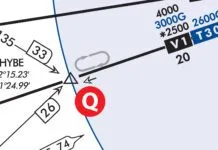Need Datalink? Got Datalink!
Reference Fred Simonds article “Need Datalink?” in the May 2014 issue. We first put datalink into our Bonanza about a dozen years ago after being stuck for a few extra days by weather. We had a post-mounted StratoCheetah by Echo Flight that used the Iridium satellite system. It worked reasonably well but was intrusive. Next a panel upgrade included the, then, UPSAT MX-20 with WSI datalink FIS. This is what we still use today in contrast to the XMWX system mentioned as the only available system in the article. There are some differences in the data and presentation, but the WSI receiver provides most of the same information as XM systems I have used.
I also use my iPad and iPhone with a Stratus ADS-B receiver, particularly while instructing. While it is true that ADS-B only provides information once airborne, I find that my iPad (or iPhone) does just fine on the ground, should I need a last minute check before launch. Check the weather using cellular data before takeoff then connect to the Stratus as a last checklist item.
Great article; I would agree with his answer. Need datalink? Absolutely. It has enabled and enhanced many trips in the dozen or so years I have been using it.
David W. Dodson, CFII
South Bend, IN
Direct-To…How?
I do a fair amount of instrument instruction in /A aircraft and the question of whether we can accept or request direct routing without any GPS at all always comes up. Erring on the conservative side, I’ve taught the “unable” response, requesting a vector, even though we’re almost always using a portable GPS of some form for situational awareness.
However my research on the question brought me back to the May 2010 issue of IFR and an article by Jeff Van West. He essentially asserts that as long as you can be confident in your navigation, assume obstruction clearance and remain in radar contact, you can request direct to anywhere by any means you want.
Really? Can we hit direct on our iPads and happily go there under IFR?
Josh Wigotow
Lancaster, PA
Your note spurred a conversation with Jeff and he’s backing off that stance a bit.
Even if all you’ve got in the panel is an old VOR receiver, you can still go direct to any point on the planet with a suitable portable or tablet. Legally? Well, not quite.
Your original thought was correct.
When you’re given or request direct, just request, “Vector, heading xyz, direct when able.” You know what’s up, the controller likely knows it too, but the vector assures that you’ll remain legal by clarifying that you’re navigating with radar oversight, which, in fairness to Jeff’s original assertion, was one of the requirements.
Should you lose radar oversight, you’ll need a backup for safety. That backup might be a nearby VOR or other navaid, and should also include a safe altitude. So, you should maintain situational awareness and even cross-check your position with the stuff on the panel once in a while.
Finally, note that GPS-direct is a great-circle path whose heading varies. If your target is some distance away, you may find that the requisite heading changes enough to concern you. Don’t worry about it unless the heading varies by more than, say, five degrees. If it does, just request an update, “We’re currently on heading xyz, direct ABC when able. That doesn’t seem to quite be working. Request heading wxy, direct ABC when able.” Practically speaking, though, since you’re on radar by definition in the first place…
Pilot Shortage? Just Pay More.
I just read your April article “Pilot Shortage Arrives.” I agree that there is a developing problem. You mention one possible answer is to get young people interested in aviation. I think that solves nothing. They’re already interested.
What child isn’t fascinated by flying machines?
The trick is to keep their interest when they are old enough to matter. The way to keep a person’s interest is money. Why do high school or college kids want to be doctors, lawyers, engineers? Because it pays!
Look at a doctor for example. They have to pay a ton for training to practice medicine. But their reward is justifiable financially. A pilot on the other hand may spend as much as a doctor for their training, and after they slave away as a CFI, they get to take a pay cut and go fly for a regional airline for less than minimum wage.
Next time you want to see genuine shock on someone’s face, tell them how much a first-year first officer makes. It amazes me that someone is willing to take on that much responsibility for that pittance of a wage. That is the problem; as long as someone is willing to work for almost free, there will be a pilot shortage. Raise the standard. Raise the pay. The “problem” will go away.
Kevin Bell
Idaho Falls, Idaho
I agree, Kevin. And I have many times shocked people—and passengers—by telling them regional airline first officer starting pay is typically under $25,000.
But, I think you missed the point. And, to be fair, I did, too—at least a bit—by not better connecting the airline shortage to student starts.
Yes, I started with the commercial pilot shortage. And, you’re right that the shortage would be smaller or even nonexistent if those jobs paid a living wage at the beginning. But, if there aren’t enough student starts at the bottom, there eventually won’t be enough ATPs for the airline jobs. And, do we really want professional pilots who embark on that path solely because the career pays well? I surely don’t.
But, face it, if we had a lot more GA activity, the natural growth of that would be a greater supply of addicts, er, pilots who would even still be willing to take those meager-paying initial jobs, just to feed their addiction.
So, while low pay is a horrible reality, the real problem is at the bottom end. We’re just not drawing enough people into aviation in the first place. And, I was making the parallel point that GA is going to come apart at the seams if we don’t get more pilots/consumers out there.
What a GAASS
In the May 2014 “On the Air,” Mark Klebanoff mentions the GAASS intersection.
I have ForeFlight on my iPad and was able to go direct to GAASS. However, I was unable to locate the waypoint on the sectional, or a low or high enroute IFR chart. I also tried to see if it was part of an approach, all without success.
Is there a web site that list waypoints and their usage and history? I have found other waypoints, some on airways, that have interesting names that may have historical interest. Some of these also seem not to have a particular use.
David Wilkus
Wichita, Kansas
There’s probably a better way, but here’s what we did.
First, lookup the fix on AirNav.com. It could be on any kind of chart, including charted procedures. In the case of GAASS, it’s listed as a STAR RNAV fix. If the fix is on a charted procedure, look at the nearby airports listed for the fix. If there’s an obvious one, try looking on the appropriate procedures associated with that airport to see if you can find it. GAASS is near Atlanta’s Dekalb-Peachtree airport, but GAASS is not on any of those arrivals.
The next step was to see exactly where GAASS is. For that, we did what you did and simply created a route to it on one of the popular charting programs. GAASS isn’t depicted on the sectional since it’s a STAR fix, but the route shows it northeast of Atlanta in the Class B. Knowing that, we started searching the ATL arrival procedures and found GAASS depicted on the EVULE1: PLEES, SHANE, EVULE, SMELY, GAASS, KLOWD, REAKS.
Hmmm…bet there’s a story there.
Yes, that’s a circuitous process just to find a fix. But as is often true, the journey can be half the fun.
We read ‘em all and try to answer most e-mail, but it can take a month or more. Please be sure to include your full name and location. Contact us at IFR@BelvoirPubs.com.




